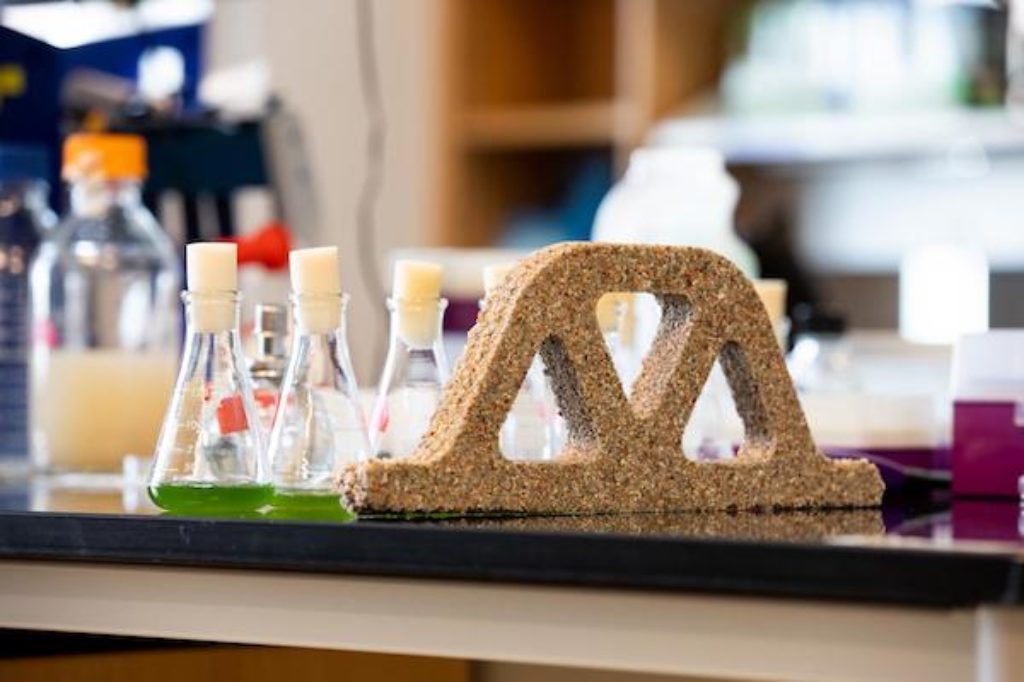
[Image above] Researchers at the University of Colorado Boulder developed living building materials that consist of a sand-hydrogel framework biomineralized by photosynthetic cyanobacteria. Credit: College of Engineering and Applied Science at Colorado University Boulder
Cement is a popular topic here on CTT—possibly because it’s one of the world’s most ubiquitous building materials.
According to a 2017 Quartz article, the world uses 4.2 trillion kg of cement every year—that’s enough to build 1,000 Hoover Dams per year, or about 2.7 Hoover Dams every day. That’s a whole lot of cement, a whole lot of concrete, and a whole lot of global CO2 emissions (8% of the global total, in fact).
Although the formulation for cement has changed remarkably little over the past few thousands of years, the material is frequently the target of research efforts to bring its composition into modern times.
Efforts to update the composition include making versions of cement that drastically reduce the material’s carbon footprint, for example, by absorbing rather than releasing CO2 and requiring less energy and resources for manufacturing.
Other cementitious makeovers focus on making the material perform better and last longer by developing formulations that are self-healing, including one that uses microcapsules containing healing agents and another equipped with living fungal spores that can be reactivated to secrete calcium carbonate.
To me, that last one is a notably interesting concept—combining biology and materials science together to creating “living building materials” (LBMs). It makes sense when you consider that many living organisms, including fungi, bacteria, and various marine organisms, inherently form minerals in a process called biomineralization.
Perhaps most familiar are those marine organisms that deposit nacre, or mother-of-pearl, an often-studied biomaterial because of its high strength and toughness.
When it comes to concrete, various researchers turned to bacteria or fungi capable of biomineralization because of these organisms’ small size and often impressive durability and resilience to survive in challenging environments.
But cement isn’t exactly a favorable place for even durable creatures to survive, and viability has been a major limitation of bioconcretes thus far.
So instead of finding a way to get organisms to survive in traditional concrete, researchers at the University of Colorado Boulder are taking a different approach—by specifically designing a cementitious material around the organisms, increasing the viability of LBMs.
Using photosynthetic cyanobacteria (a species of Synechococcus called PCC 7002), the team designed a happy home for the organisms out of a mixture that I like to think of as beach Jell-O—sand embedded in standard, grocery-store gelatin.
The sand–gelatin mixture provided a scaffold in which the microbes could grow as well as a structural support that allowed the team to design various shapes embedded with living cyanobacteria.
Under favorable growing conditions (dictated by temperature and humidity), the cyanobacteria within just a few days secreted enough calcium carbonate to cement the support materials together, resulting in a reasonably hardened LBM.
Using various molds, the team created bricks, blocks, and even more complex trusses, complete with struts and cutouts, using the sand–gelatin mixture cemented together by cyanobacteria-secreted calcium carbonate.
And because the cyanobacteria are photosynthetic, they contain chlorophyll—meaning the organisms, and their bricks, blocks, and shapes, are green.
“It really does look like a Frankenstein material,” Wil Srubar, structural engineer and senior author, says in a The New York Times article about the work.
Perhaps even more science-fiction, the research team showed the bricks can beget more bricks. “The group can take one block, cut it with a diamond-tipped saw, place half back in a warm beaker with more raw materials, pour it in a mold, and begin concrete formation anew,” the NYT article explains. “Each block could thus spawn three new generations, yielding eight descendant blocks.”
However, the green color does fade out after the bricks dry, a process that also increases their structural integrity. In an open-access paper describing their work, the researchers report the results of compressive strength and fracture tests with the cyanobacteria-bound bricks, demonstrating increased compressive strength and fracture energy compared to similar bricks without any living organisms (which isn’t that impressive considering those bricks are composed of only sand and gelatin).
Although the bacterially bound bricks are much weaker than conventional concrete, the authors indicate that is not their purpose. “LBMs are not intended to broadly replace cementitious materials, but instead represent a new class of materials in which structural function is complemented by biological functionalities,” they write in the paper.
This new class of materials is not only recyclable and much more sustainable as a building material, but it is incredibly versatile as well. “We’re not pigeonholed into using some particular kind of sand,” Srubar notes in the NY Times article. “We could use waste materials like ground glass or recycled concrete.”
That versatility is key to the interesting part of this research—it’s not the development of “living concrete,” but that the team has created an entirely different kind of building material that is really well-suited for resource-limited settings.
And that offers intriguing possibilities for things like expeditions beyond this planet. “There’s no way we’re going to carry building materials to space,” Srubar says in the NYT article. “We’ll bring biology with us.”
The open-access paper, published in Matter, is “Biomineralization and successive regeneration of engineered living building materials” (DOI: 10.1016/j.matt.2019.11.016).
